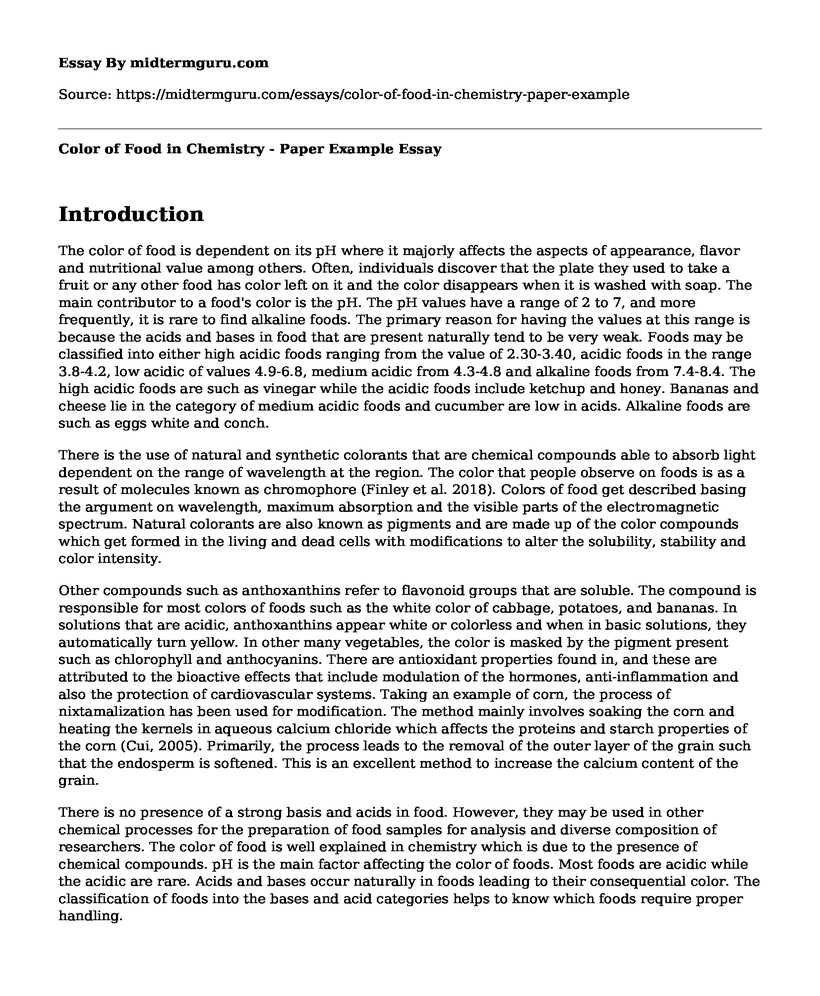Introduction
The color of food is dependent on its pH where it majorly affects the aspects of appearance, flavor and nutritional value among others. Often, individuals discover that the plate they used to take a fruit or any other food has color left on it and the color disappears when it is washed with soap. The main contributor to a food's color is the pH. The pH values have a range of 2 to 7, and more frequently, it is rare to find alkaline foods. The primary reason for having the values at this range is because the acids and bases in food that are present naturally tend to be very weak. Foods may be classified into either high acidic foods ranging from the value of 2.30-3.40, acidic foods in the range 3.8-4.2, low acidic of values 4.9-6.8, medium acidic from 4.3-4.8 and alkaline foods from 7.4-8.4. The high acidic foods are such as vinegar while the acidic foods include ketchup and honey. Bananas and cheese lie in the category of medium acidic foods and cucumber are low in acids. Alkaline foods are such as eggs white and conch.
There is the use of natural and synthetic colorants that are chemical compounds able to absorb light dependent on the range of wavelength at the region. The color that people observe on foods is as a result of molecules known as chromophore (Finley et al. 2018). Colors of food get described basing the argument on wavelength, maximum absorption and the visible parts of the electromagnetic spectrum. Natural colorants are also known as pigments and are made up of the color compounds which get formed in the living and dead cells with modifications to alter the solubility, stability and color intensity.
Other compounds such as anthoxanthins refer to flavonoid groups that are soluble. The compound is responsible for most colors of foods such as the white color of cabbage, potatoes, and bananas. In solutions that are acidic, anthoxanthins appear white or colorless and when in basic solutions, they automatically turn yellow. In other many vegetables, the color is masked by the pigment present such as chlorophyll and anthocyanins. There are antioxidant properties found in, and these are attributed to the bioactive effects that include modulation of the hormones, anti-inflammation and also the protection of cardiovascular systems. Taking an example of corn, the process of nixtamalization has been used for modification. The method mainly involves soaking the corn and heating the kernels in aqueous calcium chloride which affects the proteins and starch properties of the corn (Cui, 2005). Primarily, the process leads to the removal of the outer layer of the grain such that the endosperm is softened. This is an excellent method to increase the calcium content of the grain.
There is no presence of a strong basis and acids in food. However, they may be used in other chemical processes for the preparation of food samples for analysis and diverse composition of researchers. The color of food is well explained in chemistry which is due to the presence of chemical compounds. pH is the main factor affecting the color of foods. Most foods are acidic while the acidic are rare. Acids and bases occur naturally in foods leading to their consequential color. The classification of foods into the bases and acid categories helps to know which foods require proper handling.
References
Cui, S. W. (2005). Food carbohydrates: chemistry, physical properties, and applications. CRC press.
Finley, J. W., Hurst, W. J., & Lee, C. Y. (2018). Principles of food chemistry. Springer.
Cite this page
Color of Food in Chemistry - Paper Example. (2022, Sep 21). Retrieved from https://midtermguru.com/essays/color-of-food-in-chemistry-paper-example
If you are the original author of this essay and no longer wish to have it published on the midtermguru.com website, please click below to request its removal:
- Critical Response on Genesis: The Ark Before Noah - Paper Example
- Essay Methods of Assessing the Risk: Chemical Hazards
- Gain Healthy Diet Knowledge With $100,000 Fund for Nourishment - Essay Sample
- Inequalities: Understanding the Language of Math in Everyday Life - Essay Sample
- The Earliest Bipedal Hominids: Taung Child & Neanderthals - Essay Sample
- Fast Food: Why Do People Choose Unhealthy Options? - Essay Sample
- DRIs: Essential Tool in Healthy Diet Planning & Assessment - Essay Sample







